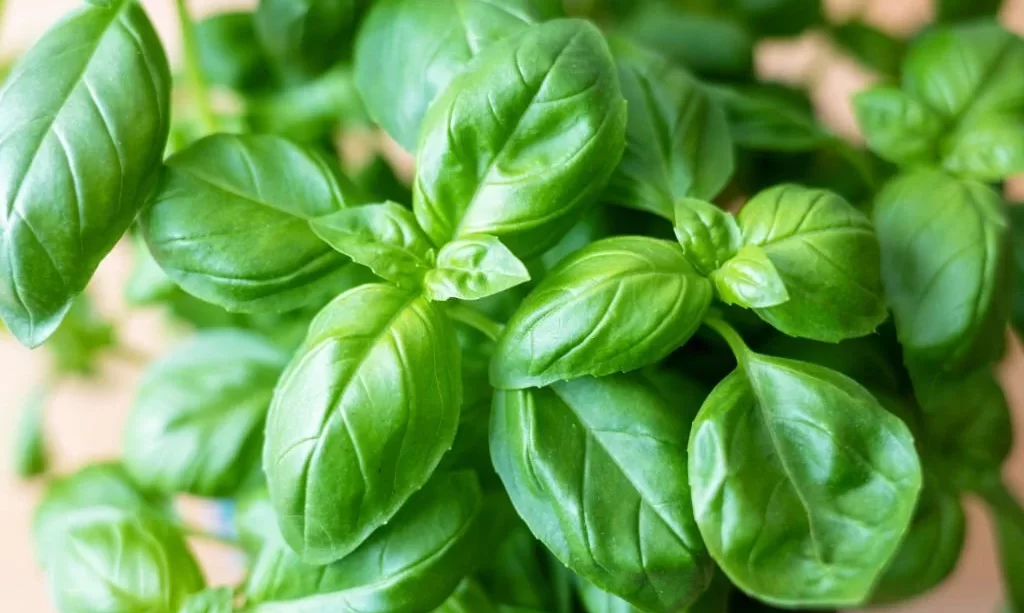Basil, with its aromatic leaves and distinctive flavor, is a beloved herb in gardens and kitchens worldwide. Its vibrant green foliage not only adds zest to various culinary dishes but also enhances the visual appeal of any garden. However, for basil enthusiasts, the sight of basil leaves turning yellow can be disheartening. When this cherished herb loses its lush green hue, it often signals an underlying issue that requires attention.
In this guide, we will delve into the common reasons why basil plants may turn yellow, offering insights and solutions to help you revive your basil and maintain its vitality. Our journey begins with a prevalent culprit: overwatering.
Overwatering
Overwatering is a frequent cause of basil leaves turning yellow. Basil plants, while requiring consistent moisture, are sensitive to waterlogged conditions. Here’s how overwatering can impact your basil:
Symptoms of Overwatering:
- Yellowing leaves, particularly at the base of the plant.
- Leaves may become droopy, with a limp or wilted appearance.
- The soil may feel consistently wet or soggy.
Preventing Overwatering:
- Check Soil Moisture: Before watering, always check the moisture level of the soil. Stick your finger about an inch into the soil; if it feels dry at this depth, it’s time to water. If it’s still moist, wait a bit longer.
- Proper Drainage: Ensure that your basil plant’s container or garden bed has proper drainage. Excess water should be able to flow away from the roots to prevent waterlogged soil.
- Watering Frequency: Basil typically prefers to dry out slightly between waterings. Water deeply but less frequently rather than giving it small, frequent sips of water.
By addressing overwatering and allowing the soil to dry out between waterings, you can prevent your basil leaves from turning yellow due to excessive moisture. In the following sections, we’ll explore other potential causes of yellowing basil and provide guidance on how to maintain the health and vibrancy of this delightful herb.
Underwatering
While overwatering is a common cause of basil leaves turning yellow, the opposite extreme, underwatering, can also lead to the same troubling symptom. Basil requires consistent moisture, and when it doesn’t receive an adequate water supply, it can respond with yellowing leaves. Here’s how underwatering affects basil and how to address it:
Symptoms of Underwatering:
- Leaves turning yellow and appearing dry.
- Basil leaves may become brittle and prone to wilting.
- Soil is consistently dry, even to a considerable depth.
Preventing Underwatering:
- Regular Checkups: Make it a routine to check your basil’s soil moisture regularly. When the top inch of soil is dry to the touch, it’s time to water.
- Proper Watering Technique: When you water, do so thoroughly, allowing water to penetrate the root zone. Water until you see excess water draining from the bottom of the pot or garden bed.
- Mulching: Applying a layer of organic mulch around your basil plants can help retain soil moisture, reducing the risk of underwatering.
Addressing underwatering by providing your basil with adequate moisture ensures that it remains healthy and vibrant, free from the stress that can lead to yellowing leaves.
- 🌱 ALL NATURAL MIX Suitable For Use On Edible Plants like FRUITS & VEGETABLES
- 🍎 MYCORRHIZAE ENRICHMENT — Aids Root Growth as well as increased Nutrient Absorption for your Plants
- 💧EASY-TO-MANAGE DRAINAGE — Blended with Perfect Plants Perlite
- 🏺 BEST FOR PLANTS IN CONTAINERS — Great for Indoor and Outdoor Use
- 🔗 RE-SEALABLE, Heavy Duty Bag Perfect for Storage
Poor Drainage
Inadequate drainage is another factor that can contribute to basil leaves turning yellow. Basil plants thrive in well-draining soil, and when the roots sit in waterlogged conditions, problems can arise. Here’s how poor drainage impacts basil and how to improve it:
Effects of Poor Drainage:
- Soil remains consistently wet, increasing the risk of root rot.
- Basil roots become deprived of oxygen, leading to stress and yellowing leaves.
- The plant may appear wilted, even if the soil is overly wet.
Improving Drainage:
- Choose the Right Container or Location: If growing basil in a pot, ensure it has drainage holes. In the garden, select an elevated spot or amend the soil to improve drainage.
- Well-Draining Soil: Use well-draining potting mix or amend garden soil with organic matter like compost to enhance drainage.
- Avoid Overcrowding: Plant basil with adequate spacing to prevent overcrowding, which can lead to poor air circulation and water buildup.
By addressing poor drainage and creating an environment where excess water can escape, you can help your basil thrive and avoid the stress that often leads to yellowing leaves. In the subsequent sections, we’ll explore other potential causes of yellowing basil and provide insights on maintaining its vibrancy.
Nutrient Deficiencies
Nutrient deficiencies, particularly a lack of essential nutrients like nitrogen, can result in basil leaves turning yellow. Basil is a moderately heavy feeder, meaning it requires a steady supply of nutrients to grow lush and green. Here’s how nutrient deficiencies can impact basil and how to address them:
Symptoms of Nutrient Deficiencies:
- Yellowing of older leaves, starting at the bottom of the plant.
- Reduced growth and overall plant vigor.
- Leaves may appear smaller and less vibrant.
Addressing Nutrient Deficiencies:
- Fertilize Appropriately: Use a balanced, water-soluble fertilizer that includes nitrogen, phosphorus, and potassium. Follow the manufacturer’s instructions for application rates and frequency.
- Mulching: Apply organic mulch to the soil surface to help retain moisture and nutrients. As the mulch breaks down, it releases nutrients into the soil.
- Compost: Incorporate compost into the soil to enrich it with organic matter and essential nutrients.
By providing your basil plants with the necessary nutrients, you can promote healthy growth and prevent yellowing leaves due to nutrient deficiencies.
- Organic Vegetable Fertilizer Spikes: EarthPods provide balanced, natural nutrients for your vegetable garden, perfect for growing tomatoes, peppers, spinach, lettuce, and more; A great organic fertilizer for small-space gardens and containers.
- Slow-Release Herb Fertilizer for Potted Plants: Designed for gradual nutrient release, EarthPods keep your basil, dill, cilantro, mint, parsley, and other kitchen herbs nourished over time in both indoor and outdoor edible gardens.
- Ideal for Small-Space & Container Gardens: EarthPods offer an easy, mess-free solution for feeding vegetables, culinary herbs, and leafy greens in pots, containers, and raised beds; Perfect for urban and small-space gardeners seeking a versatile veggie fertilizer.
- Effortless Application for All Gardener Skill Levels: Just push EarthPods into the soil and water; No messy mixing or measuring needed; Great for beginners and experienced gardeners alike, EarthPods are the go-to herb plant food for simple, reliable results.
- Easy Organic Fertilizer for Vegetable Gardens: Made from natural ingredients, EarthPods support friendly gardening practices while delivering the essential nutrients your vegetable and herb plants need.
Pests and Diseases
Pests and diseases can also be responsible for basil leaves turning yellow. Basil is susceptible to various insect pests and fungal diseases that can impact its health. Here’s how to identify and address common issues related to pests and diseases:
Symptoms of Pests and Diseases:
- Discolored and distorted leaves.
- Small insects like aphids or spider mites on the plant.
- White or brown spots on leaves, a common sign of fungal diseases like downy mildew.
Addressing Pests and Diseases:
- Identify the Culprit: Examine your basil plants regularly for signs of pests or diseases. Identify the specific issue to determine the appropriate treatment.
- Natural Predators: Encourage beneficial insects like ladybugs and lacewings that prey on common basil pests.
- Pruning and Removing Affected Leaves: If you notice infected or infested leaves, promptly prune and remove them to prevent the issue from spreading.
- Fungicide or Insecticidal Soap: In severe cases, consider using organic fungicides or insecticidal soap to control the problem. Follow the product’s instructions carefully.
By keeping a vigilant eye on your basil plants and taking action at the first sign of pests or diseases, you can protect their health and vibrant green color. In the following sections, we’ll explore additional factors that can contribute to basil leaves turning yellow and offer guidance on maintaining a thriving basil garden.
Temperature Stress
Temperature stress, whether from cold snaps or excessively hot weather, can lead to basil leaves turning yellow. Basil plants thrive in moderate temperatures and can become stressed when exposed to extreme conditions. Here’s how temperature stress affects basil and how to mitigate its impact:
Effects of Temperature Stress:
- Cold Stress: Basil can develop yellowing leaves when exposed to temperatures below 50°F (10°C). Leaves may become discolored, and the plant may appear wilted.
- Heat Stress: In excessively hot weather, basil may also exhibit yellowing leaves, especially if it lacks sufficient moisture. Leaves may droop and lose their vibrant green color.
Mitigating Temperature Stress:
- Cold Protection: If cold nights are expected, cover your basil plants with a cloth or plant blanket to retain warmth. Remove the cover during the day to allow sunlight and air circulation.
- Shade in Hot Weather: Provide shade to your basil plants during scorching summer days. Use shade cloth or place them in a location that receives partial sunlight to reduce heat stress.
- Maintain Adequate Moisture: Ensure your basil plants receive consistent watering, especially during hot weather. Adequate moisture helps them cope with temperature fluctuations.
By protecting your basil from temperature extremes and providing the right conditions, you can prevent yellowing leaves due to temperature stress.
Conclusion
In conclusion, the vibrant green leaves of basil are a delightful addition to any garden and culinary repertoire. However, when basil leaves turn yellow, it’s a sign that the plant may be facing various challenges. This guide has explored the common reasons why basil plants may turn yellow and offered solutions to address each issue.
From overwatering and underwatering to poor drainage, nutrient deficiencies, pests, diseases, and temperature stress, there are several factors that can impact the health of your basil. By identifying the cause of yellowing leaves and taking appropriate action, you can help your basil thrive and continue to provide fresh, aromatic leaves for your culinary creations.
Remember to maintain a vigilant eye on your basil plants, practice proper care, and create an environment that supports their well-being. With these efforts, you can enjoy the lush green beauty and flavorful bounty of your basil garden for seasons to come.






